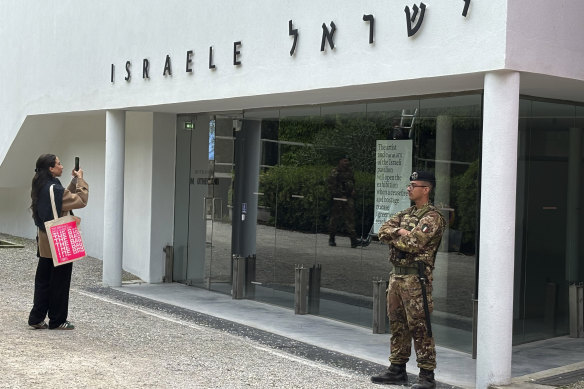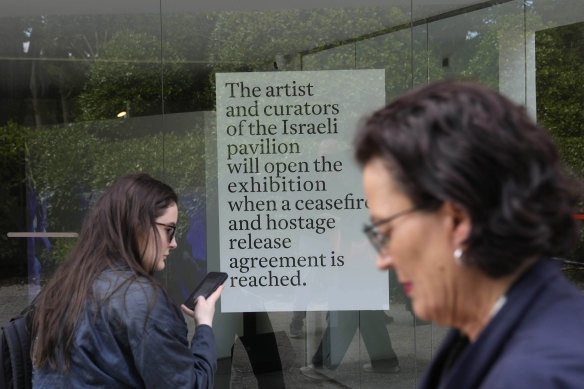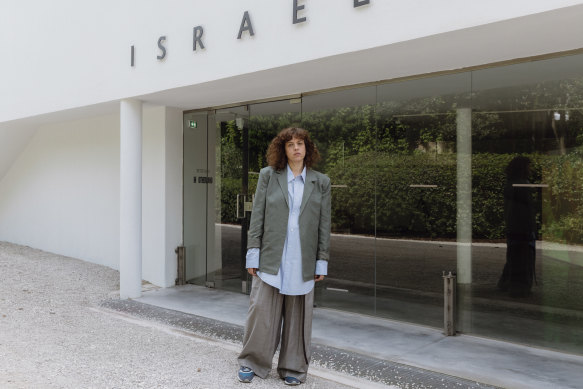This was published 1 year ago
Israeli artist shuts down Biennale show, urging ceasefire
By Alex Marshall
Venice, Italy – Since February, thousands of pro-Palestinian activists have tried in vain to get the Venice Biennale, one of the world’s most prestigious international art exhibitions, to ban Israel over its conduct of the war in the Gaza Strip.
But this week, when the Biennale’s international pavilions open for a media preview, the doors to the Israel pavilion will nonetheless remain locked, at the behest of the artist and curators representing Israel.

A woman takes a photo as an Italian soldier patrols the Israeli pavilion at the Biennale art fair in Venice on Tuesday.Credit: AP
“The artist and curators of the Israeli pavilion will open the exhibition when a ceasefire and hostage release agreement is reached,” reads a sign that the Israeli team taped to the door of the pavilion.
“I hate it,” Ruth Patir, the artist chosen to represent Israel, said in an interview about her decision not to open the exhibit she has been working on, “but I think it’s important”.
She said that while the Biennale, which opens to the public on Saturday, is a huge opportunity for a young artist like herself, the situation in Gaza was “so much bigger than me”, and she felt that closing the pavilion was the only action she could take.
The war has cast a shadow over major cultural events. Since the October 7 Hamas attacks in southern Israel, in which Israeli officials said about 1200 people were killed and 240 taken hostage, and Israel’s campaign in Gaza, which authorities there say has killed more than 33,000 people, artists have reacted at major events around the world. There have been protests from the stages of the Academy Awards and the Grammy Awards; an artist subtly included a “Free Palestine” message in his work at the Whitney Biennial; and there have been debates about Israel’s participation in the Eurovision Song Contest.

The sign on the closed Israeli national pavilion on Tuesday.Credit: AP
Those protests all came from outside Israel. And although many Israelis share Patir’s desire for a ceasefire and hostage deal, a call for a ceasefire from an artist representing the country at an important international event could draw criticism from Israeli lawmakers, said Tamar Margalit, an Israel pavilion curator who reached the decision with Patir and Mira Lapidot, another curator of the pavilion.
Israel’s government, which has paid about half the pavilion’s costs, was not informed in advance about the protest, Margalit said. The Israeli Culture Ministry did not immediately reply to a request for comment Tuesday.
Margalit said visitors would still be able to see one of Patir’s video pieces through the pavilion’s windows. For that piece, Patir used computers to animate images of ancient fertility statues, which are a recurring motif in her work. The female statues, many cracked or missing limbs, come to life in the film and move around, wailing with grief and anger.
Patir said the artwork, finished this month, reflected her sadness and frustration over the conflict. The emotions depicted in the film “felt accurate to the experience of living in this moment”, she added.

The artist Ruth Patir, Israel’s representative, outside the Israeli pavilion at the Venice Biennale.Credit: New York Times
The furor around Israel’s pavilion this year began in February when Art Not Genocide Alliance, an activist group, published an open letter urging a ban over what it said were Israel’s “ongoing atrocities” in Gaza.
“Any official representation of Israel on the international cultural stage is an endorsement of its policies and of the genocide in Gaza,” the letter said. Its signatories included photographer and activist Nan Goldin, and artists representing their countries in 14 of this year’s Biennale pavilions, including those of Chile, Finland and Nigeria.
On Tuesday, Art Not Genocide Alliance said in a statement on Instagram that Patir’s protest was an empty and opportunistic gesture “timed for maximum press coverage”. Patir shouldn’t be showing a video work even with the pavilion’s doors locked, the statement added.
In its February letter, the group drew historical parallels to try to justify its call for a ban. In the 1960s, Italy’s government barred South Africa over apartheid. And when Russia launched its full-scale invasion of Ukraine in 2022, the Russian artists chosen to represent it decided to withdraw. (Russia is not taking part again this year, and has lent its large pavilion, in a prime location in the Biennale gardens, to Bolivia.)
The Biennale’s organisers dismissed those comparisons, saying that any country recognised by Italy’s government was free to take part. Italian lawmakers gave an even stronger endorsement. In February, Gennaro Sangiuliano, Italy’s culture minister, said Israel had both “the right to express its art” and a duty to “bear witness to its people precisely at a time like this when it has been ruthlessly struck by merciless terrorists”.
This article originally appeared in The New York Times.